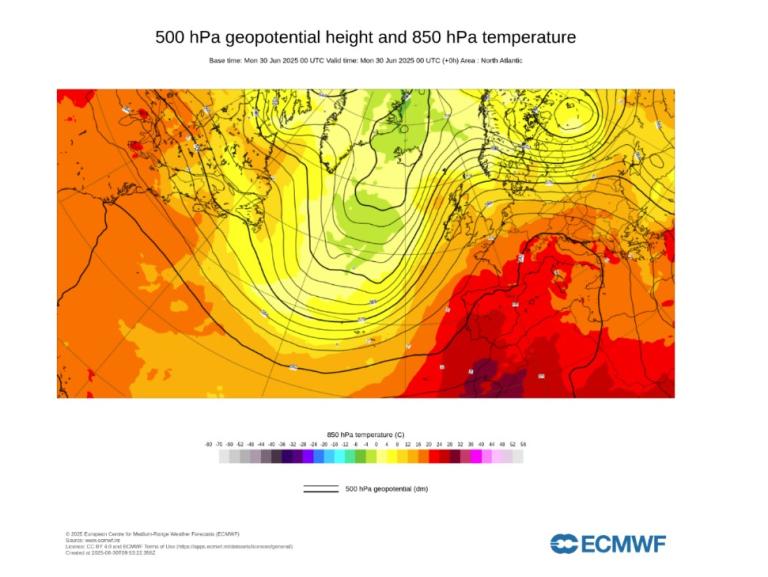The World Meteorological Organization, its members and partners are ramping up action against extreme heat to protect lives from what is widely described as a silent killer.
As a result of human-induced climate change, extreme heat is becoming more frequent and intense. Warnings from National Meteorological and Hydrological Services and coordinated heat-health action plans are therefore increasingly important to protect public safety and well-being.
July is typically the warmest month of the year in the Northern hemisphere.
Heat conditions and well above average temperatures are currently impacting many parts of Western Europe, parts of North America, North Africa, the Middle East and Central Asia.
Western Europe is under influence of a strong high-pressure system, trapping dry air from northern Africa over the region and leading to extreme heat which is having a major impact on all aspects of daily life.
In western and south-western Europe both minimum (representative of nighttime conditions) and maximum temperatures (usually occurring during the afternoon) broke monthly station records for June in some locations.
What is exceptional not only in terms of magnitude but also for the time of the year, as these episodes of extreme heat typically occur during the height of summer.
Sea surface temperatures (SSTs) of Mediterranean Sea are also exceptionally warm for the time of the year that tend to reinforce the extreme temperatures over land areas.

Some examples:
AEMET - Agencia Estatal de Meteorología recorded a temperature of 46.0°C at the weekend in southern Spain. Portugal, Italy and Greece have also been gripped by intense heat.
Meteo-France has issued a top-level red (danger to life) alert for 1 and 2 July for 16 departments and 68 departments have an amber alert, with widespread temperatures above 40°C.
MeteoSwiss also has an amber alert for most locations, including Geneva.
The heat in Europe is coming up from the African continent. The high-pressure system creates a dome of heat, compressing air towards the surface and increasing temperatures.
Morocco has reported widespread temperatures of above 45°C during an extended heatwave, according to the Direction Générale de la Météorologie (Maroc Météo).
Additionally, inexistent or low cloud cover means that solar radiation freely reaches the surface contributing to increasing the temperatures. This weather pattern can normally stay in place for several days or even weeks leading to intense and widespread heatwave conditions.
Impacts
The effect of heat on human health is more pronounced in cities as a result of the urban heat island effect. This is where urban environments are significantly warmer than surrounding rural areas, especially during hot periods, due to an abundance of paved surfaces, buildings, vehicles, and heat sources.
This additional heat in cities exacerbates heat stress and can increase mortality during hot periods, compared to low density and rural areas, according to the European State of the Climate report produced jointly by the EU's Copernicus Climate Change Service and WMO.
More than two thirds of most severe heatwaves in Europe since 1950 have occurred since 2000, according to WMO's Regional Association VI (Europe) Regional Climate Centre Network.
The Intergovernmental Panel on Climate Change Sixth Assessment Report shows how the frequency and intensity of extreme heat events is increasing in Europe.
By 2050, about half of the European population may be exposed to high or very high risk of heat stress during summer, particularly in Southern Europe and increasingly in Eastern Europe and Western and Central Europe, it says.

WMO Action
WMO is advancing efforts to help protect people from life-threatening weather through the Early Warnings for All .
A key component is the WMO Coordination Mechanism ( WCM ) supporting crisis-prone and conflict-affected regions with timely expert advice and situational awareness, by curating authoritative weather, climate and water information from WMO Members and Centres (for example the WCM Global Hydromet Weekly Scan ).
WMO works closely with the World Health Organization through the Joint Office on Climate and Health .
Through the Global Heat Health Information Network (GHHIN) , WMO and other UN Partners are leading efforts to strengthen governance for extreme heat by providing national authorities and local governments with the technical guidance and concrete tools needed to prepare for and respond to this growing risk.
The Extreme Heat Risk Governance Project supports decision-makers in navigating institutional, legal, and operational challenges by promoting integrated approaches that connect climate, health, emergency sectors and other areas of government to work together and in a coordinated manner.
GHHIN convened global experts from 23 to 27 June in London to advance how the health impacts of extreme heat are tracked, working to improve public health surveillance systems and harmonize metrics used to monitor heat-related illness and death.
This effort will help public health agencies respond more quickly and effectively to protect vulnerable populations as heatwaves become more frequent and dangerous.






